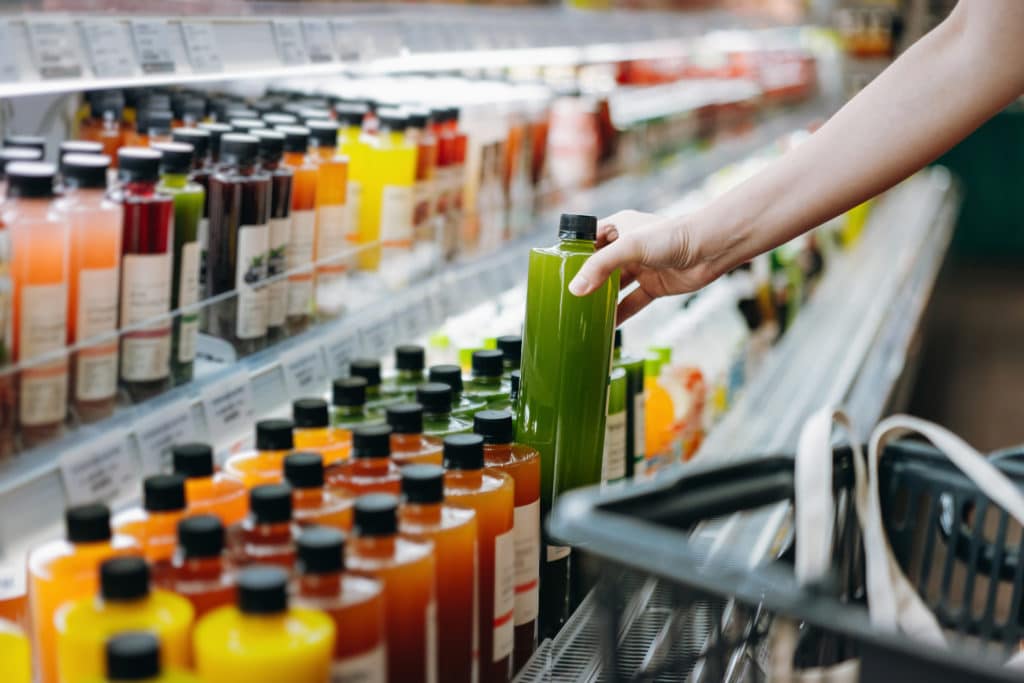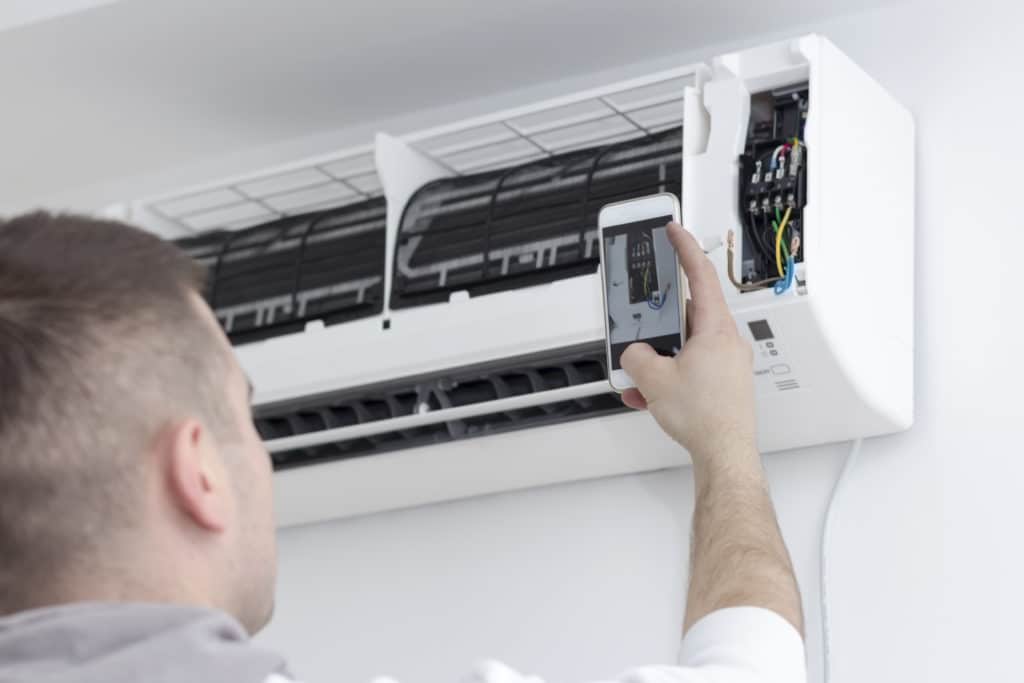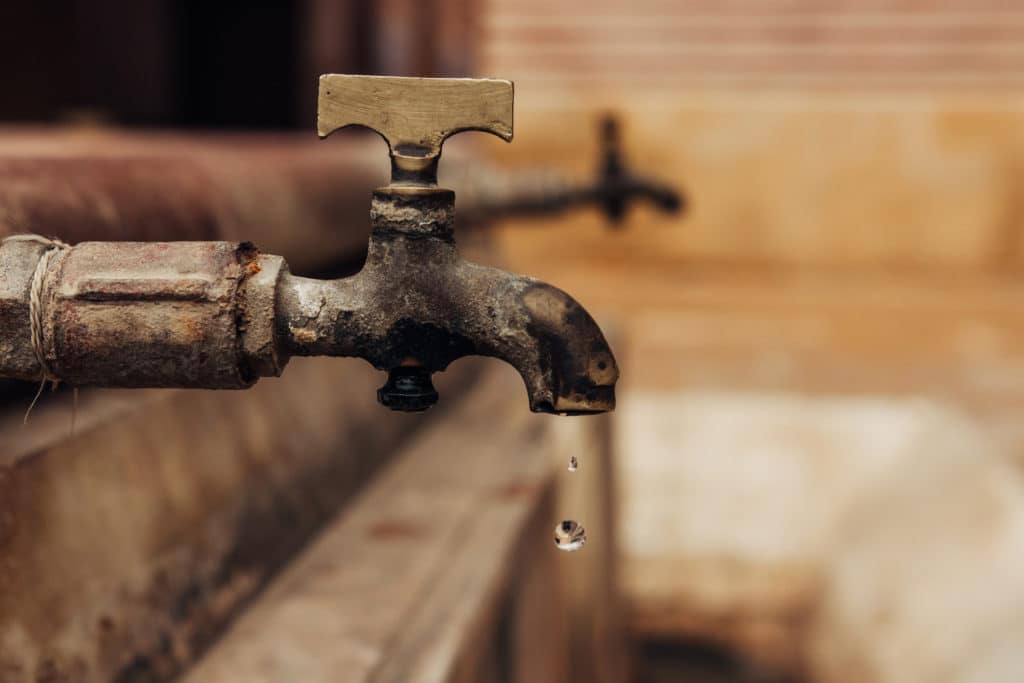The Complete Restaurant Preventive Maintenance Checklist
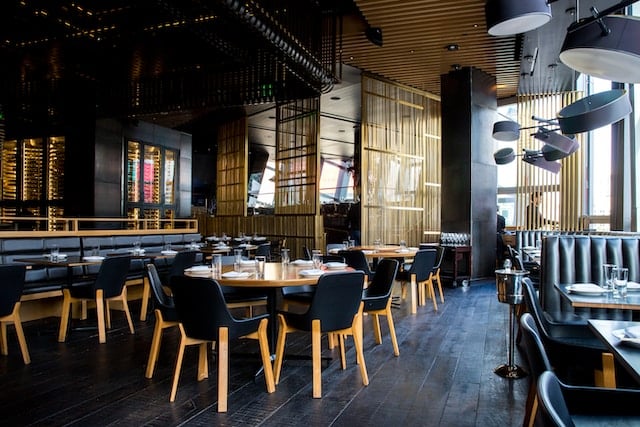
Restaurant maintenance is critical to ensuring customers have a quality experience in your establishment. Restaurant equipment maintenance also helps provide a safer and higher-quality work environment for staff.
When considering how and when to perform preventive maintenance tasks on your restaurant equipment, it helps to start with the frequency of the tasks that should be completed and where. A restaurant preventive maintenance checklist is a great place to start and iterate upon to meet your routine maintenance needs.
What is Preventive Maintenance for Restaurants?
Restaurant maintenance involves checking, repairing, and replacing equipment or systems, as well as proactively inspecting and fixing issues before they result in downtime. Restaurant preventive maintenance requires checking various systems regularly and repairing worn components before the system quits, becomes a safety hazard, or breaks down.
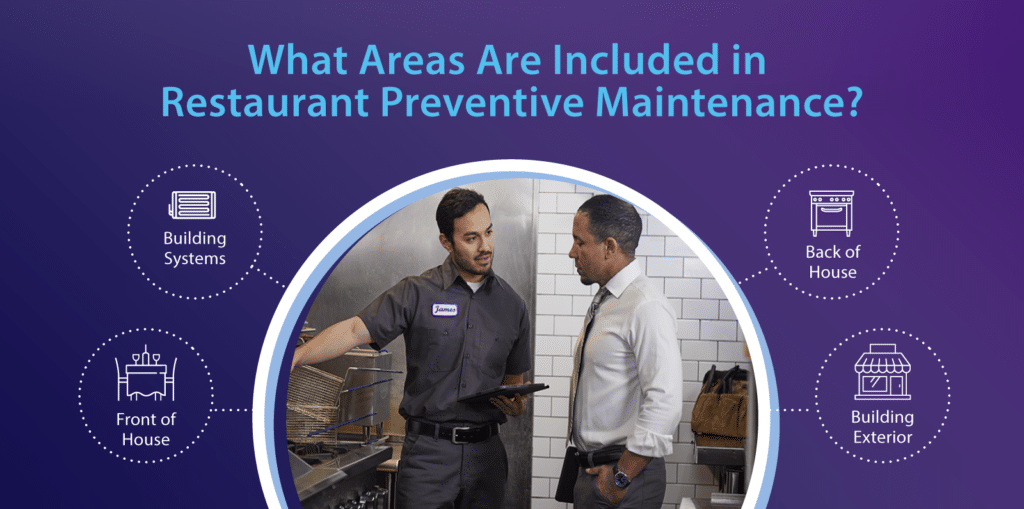
Plumbing and Drainage
Plumbing and drainage systems need regular inspection and occasional upkeep. Keeping items such as grease traps clear reduces fire hazards, while water systems like toilets, sinks, and floor drains can pose health risks or even property damage if they back up or overflow.
Kitchen Equipment
To meet health department standards and maintain the safety of staff and customers, kitchen equipment needs to function within acceptable specifications. Your restaurant maintenance checklist should include all cold-storage equipment, such as refrigerators, freezers, water filtration cartridges, ice machines, and cooking equipment like fryers, ovens, and grills. It’s also important that all preventive maintenance tasks are done according to their equipment manual.
HVAC Systems
Environmental controls are essential for customer comfort and worker safety alike. Regularly schedule equipment inspections and perform preventative maintenance of HVAC systems, including vents, filters, thermostats, and heating and AC units.
Electrical Maintenance
Light fixtures, thermal regulators, and safety equipment rely on properly functioning electrical systems. Make service checks and maintenance of switches, circuits, electrical panels, and wiring a regular part of your restaurant maintenance schedule.
Building Maintenance
Interior and exterior structural elements affect the aesthetic, safety, and comfort of everyone who walks through the restaurant doors. Schedule regular preventative maintenance for roofing and gutters, windows and doors, as well as flooring and walls. A thorough survey of landscaping and parking areas a few times a year is a good practice for any restaurant.
Pest Control Systems
Pest systems might include conventional or humane traps for rodents or insect-elimination devices. Bird controls are another frequently used pest control system. It’s essential to check pest-control systems often, as captured or terminated pests can quickly become a health risk in a facility that prepares and serves food.
Preventive Maintenance for Restaurants Scheduling
Everything about your restaurant impacts the customer experience, so restaurant preventive maintenance management must include all your company equipment, such as ovens, walk-ins, and point-of-sale systems. A comprehensive preventative maintenance program will help you save money in the long run by improving uptime and overall customer satisfaction.
- Back of the house: These are areas where typically only staff are allowed, such as the kitchen.
- Front of the house: This encompasses areas accessible by customers, such as the dining room and restrooms.
- Building systems: This refers to facility equipment not used in the trade. Examples include the building’s electrical and HVAC systems.
- The building exterior: This refers to outdoor areas, such as picnic patios, lawns, and parking spots.
Planned facilities maintenance generally covers these tasks daily, weekly, monthly, quarterly, and annually. When developing your restaurant’s preventive maintenance strategy, consider these areas:
Back of the House
Back-of-house regular equipment maintenance duties typically focus on keeping up the functionality of kitchen and storage equipment over the visual appeal of the work area. Health and safety are also primary considerations when performing these tasks.
Daily maintenance for the kitchen area focuses on more immediate tasks that impact employee workflow, equipment function, and the cleanliness of work areas. Typical tasks include cleaning grills, emptying trash, and reading internal temperatures in cold storage areas.
Weekly duties tend to prioritize buildup and other factors that would be impractical as daily tasks. Check filters to see if any need to be changed, and inspect drain lines to ensure they’re clear and flow freely.
Monthly tasks typically involve deep cleaning and preventive maintenance checks. Personnel descale coffee makers, remove grease buildup from cooking equipment, and check for signs of wear and tear on stove tops, cutting machines, and other kitchen equipment that may need to be repaired or replaced.
Quarterly back-of-house maintenance tasks aim for the bigger picture and higher impact elements of the kitchen, storage areas, and other employee-only spaces. For more complex systems, such as electrical or HVAC, restaurants often call a trusted maintenance professional for inspections and repairs. Restaurant staff can check range knobs and less complicated components for signs of breakdown or possible future equipment failures.
Front of the House
Restaurant owners typically spend a lot of resources on keeping up an aesthetically pleasing dining area and other customer-access spaces to keep the restaurant running smoothly.
Most daily front-of-house tasks prioritize visual appeal and customer safety. Personnel sweep and mop floors and wipe and sanitize surfaces several times a day. Daily opening and closing tasks usually involve a final clean of restrooms and the dining room, as well as disassembling and cleaning front-room equipment, such as soda machines and soft-serve dispensers. Parts are often left to air dry overnight and reassembled in the morning.
For weekly or monthly proper maintenance behind the counters, disconnect and clean syrup connectors on beverage dispensers, and deep clean other food processing equipment. Let everything air dry before reinstalling.
Every quarter, check the appearance of interior signs and replace them as needed. Inspect furnishings for stability. In the dining area, double-check for tripping hazards, like curled mats or raised carpeting. Repairing or replacing anything that may be a customer safety concern is important.
Building Systems
Facility systems like electrical work and HVAC significantly impact the comfort, health, and safety of personnel and customers alike. Proper building system maintenance helps reduce costs in the future and improves the overall customer experience.
Every day, watch for frayed wires and other signs of electrical issues. Spot-check power supply units and timers and immediately address any hazards or repair needs.
Do a critical systems check at least once per week. Check outlets, circuit breakers, panelboards, and other electrical distribution systems for signs of wear that may lead to a breakdown. Take a look at refrigerant levels, drain lines, and accessible vents. Also, double-check the AC and heating controls.
Perform a monthly survey of HVAC, electrical, machinery, and moving systems. Confirm that warning lights work correctly and equipment is operating at acceptable levels. Schedule repair and maintenance right away if you encounter any issues.
At least once every three months, clear any debris around exterior AC and heating units and schedule an inspection of your HVAC system. A specialist will inspect fan blades, test equipment, and ensure everything is level. Schedule any high-level systems and restaurant equipment maintenance with a top-performing restaurant maintenance provider to provide the best outcomes.
Building Exterior
Beauty and safety are the two primary concerns involved in the outdoor elements of a restaurant. You want to keep everything tidy, colorful, and pleasant to look at while ensuring that customers and staff can traverse the property smoothly.
Inspect daily to ensure ADA parking spots and sidewalks are clear of debris and tripping hazards. Double-check ramps and wheelchair access to the sidewalk to ensure they’re stable and access is smooth. Check doors and locks to make sure they function correctly and are free of obstructions.
Make sure the grass is mowed and weeds are pulled at least once a week to keep the landscaping fresh and inviting. Outdoor cosmetic tasks go a long way in creating a welcoming first impression for your customers.
Monthly or quarterly, inspect all exterior doors and confirm that locks remain secure. Check the seals around doors to ensure escaping heat and cold don’t impact your energy costs.
Schedule yearly spring planting and seasonal shrub trimming services to maintain curb appeal.
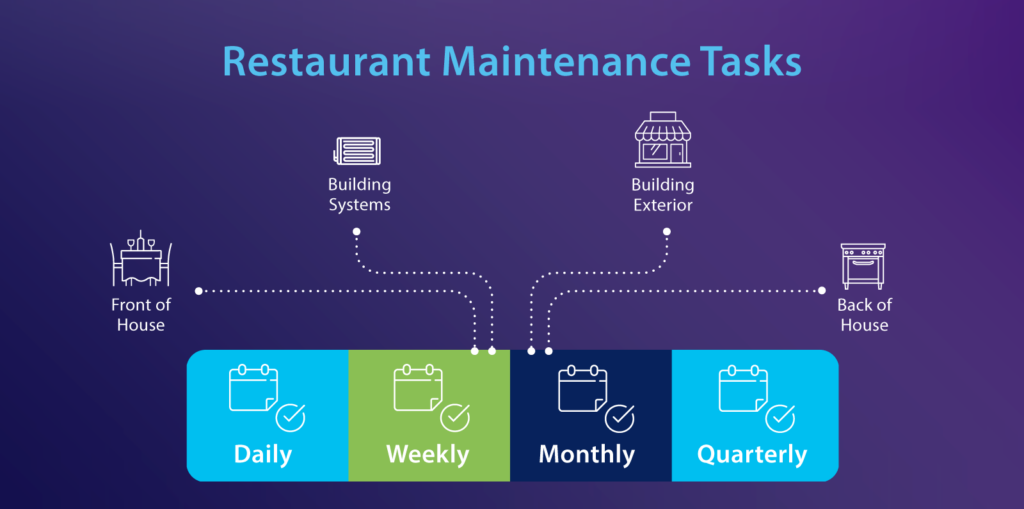
Implementing Preventive Maintenance
Create an Asset Inventory
Put together a comprehensive list of all the equipment and systems in your restaurant that require maintenance. Break the inventory down by location, keeping front-of-house, back-of-house, exterior, and building systems assets together, making them easier to track on the inventory.
Conduct Asset Analysis
Determine which assets are most critical to your restaurant’s operations and prioritize them for maintenance. More essential assets and equipment with the highest potential for producing hazards should be inspected at every interval, with the quarterly inspection being the most comprehensive.
Create a Maintenance Schedule
Establish a detailed schedule that specifies when each maintenance task needs to be performed. This schedule should cover daily, weekly, monthly, quarterly, and annual tasks. It should also determine which team or individual is responsible for the tasks on the schedule and when a service call may be needed.
Assign Responsibilities
Assign responsibilities for inspecting and maintaining each item in your asset inventory. For example, chefs and kitchen staff are often in charge of daily and weekly back-of-house tasks, while waiting and wait-support staff are usually responsible for front-of-house maintenance duties — both are responsible for a regular cleaning schedule.
Monthly and quarterly tasks most often rely on a professional or facilities maintenance personnel due to the more specialized nature of the duties. Asset-management automation that a software solution provides can further streamline responsibilities for all your staff.
Establish Maintenance Procedures
Develop processes and procedures for each maintenance task, no matter how minute. Provide step-by-step instructions to ensure the task is performed the same way every time, no matter who does it. Lay out safety guidelines, as well as necessary tools and safety equipment.
Develop an Emergency Response Plan
Prepare your staff by developing a clear emergency response plan addressing the most common safety occurrences and equipment malfunctions the restaurant industry experiences. Practice fire drills and clearly mark all emergency exits in the event of a fire. Keep your first aid kit stocked and accessible, and ensure everyone on staff knows where to find it.
Integrate Technology for Maintenance Management
Take full advantage of technology for smooth maintenance to streamline tasks like scheduling and tracking maintenance duties. A restaurant facilities management software such as ServiceChannel is ideal for ensuring lowered maintenance costs and helping your restaurant reach its operational efficiency potential.
Your Preventive Maintenance Partner
Building and facility maintenance is critical for restaurants to continue offering an excellent customer experience. Proper asset management requires preventive maintenance, with tasks performed at specific intervals. Ongoing monitoring and maintenance can prevent downtime, extend the life of assets, and control costs. Restaurants must maintain assets in the back-of-the-house and front-of-the-house and the building’s exterior. They also must maintain systems, such as electrical and HVAC.
ServiceChannel partners with restaurants to help them improve their customer experience while also lowering operating costs. ServiceChannel can help ensure kitchen equipment continually operates optimally and provides a clear maintenance picture. ServiceChannel can also help you find the best providers for your assets. Contact us to learn more about our restaurant preventive maintenance tools and services.

